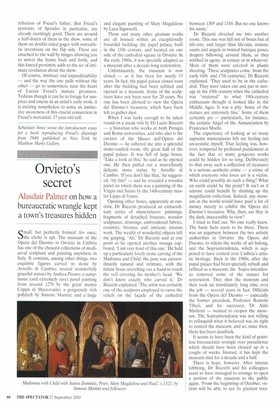Rather Perverse
Sebastian Smee
Lucian Freud: Drawings Timothy Taylor Gallery, 24 Denng Sweet London WI. until 10 October
The temptation when looking at early work by great artists is to view it almost exclusively in terms of the later achievements. If the juvenilia bears strikingly close resemblance to the later, greater things, one falls back on reassuring ideas about innate style and God-given genius; if it is not up to much, one expresses a hope-filled delight in life's capacity to offer up surprises, reversals.
The early drawings by Lucian Freud showing at the Timothy Taylor Gallery are compelling enough to be taken on their own terms. They do not warrant so sweeping a description as 'early work', for they were all done over a short period during the first winter of the second world war, when the artist was 17. Other shows, other publications, have given us a less curtailed notion of Freud's beginnings. But these
drawings do warrant — and richly reward — close, marvelling attention, since they are by far the strangest, most private and original things showing anywhere in London at the moment.
'Ancient, private and rather perverse,' is how Freud described them when he first showed them to me last year. 'They're from a very distant self.' That self had been resident in England for only seven years (the Freud family moved from Germany in 1933). The young Lucian had spent a good part of those years in the company of horses, first at Dartington Hall, then at Bryanston. 'My life was devoted to them,' he said. 'I rode the horses that were frisky so the others could ride them later on.' Hence the many drawings here of horses, each one fondly individuated with big eyes, groping neck and hairy hooves.
With one or two exceptions, these drawings were done in Capel Curig in Wales, where Freud had gone with David Kentish, a friend from art school, with the intention of spending the winter break working on pictures. Having found lodgings in a miner's cottage, they painted down the road during the day, and grew gradually more exasperated with each other during the cold, cramped evenings.
They were soon joined, however, by Stephen Spender, almost twice their age and already a successful poet. Spender had recently been to Spain to rescue an old boyfriend, Tony Hyndman, who had run off to join the International Brigade. The couple's subsequent 'second honeymoon' had precipitated the end of Spender's marriage, and it was in the immediate aftermath of this break that Spender came to Wales to join the two art students and work on his novel, The Backward Son.
Freud's drawings are ferociously individual in a way that strives actively to deny influence; but it was Spender's arrival which to a large extent provided the catalyst for the joking, fantastic spirit behind them. It was he who presented Freud with the publisher's dummy into which the young artist inscribed his inventions; and he who, much more than Kentish (who was growing increasingly jealous and sullen as the days went by), helped to knit together the atmosphere of in-joking, intimacy and creative concentration to which Freud responded.
There is a great deal of anarchic invention in these works, And yet what makes them linger in the imagination is a sense of deeper, inscrutable intent. A great many of the lines feel geologically slow, as hardpressed yet arbitrary-looking as cracks in stone walls. One instinctively imagines the artist huddled over his paper, tongue protruding between molars, mischievous gleam in his eye.
'No one was remotely interested in them,' Freud told me of his pictures. 'We must have a talk about what to do about your painting,' Spender later said. 'You don't deserve to be an artist!' was the con
tribution of Freud's father. But Freud's portraits, of Spender in particular, are already startlingly good. There are around a half-dozen of them in the show, some of them on double-sided pages with surrealistic inventions on the flip side. These are attached to the wall by hinges allowing you to swivel the frame back and forth, and this forced proximity adds to the air of intimate revelation about the show.
Of course, intimacy and unpredictability — and the way the one palls without the other — go to somewhere near the heart of Lucian Freud's mature greatness. Tedious though it can be to forage for auspices and omens in an artist's early work, it is exciting nonetheless to sense an instinctive awareness of this crucial connection in Freud's mercurial, 17-year-old self.
Sebastian Since wrote the introductory essay for a book reproducing Freud's drawings from 1940, published in New York by Matthew Marks Gallery.



























































































 Previous page
Previous page